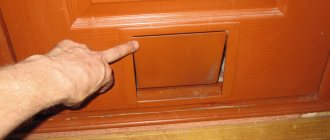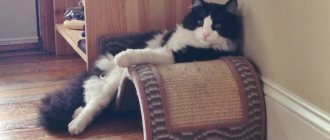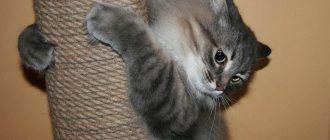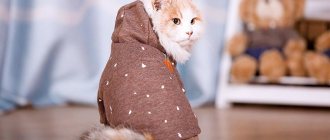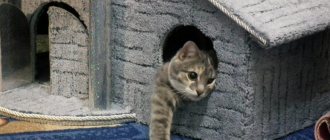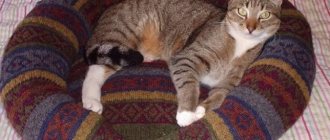Every domestic cat needs its own home. This is an individual place to relax, a refuge. A cat's home should be its property, and only its property. The place where they won’t drive her away, and where she will hide. Having your own cat house will protect you from the fact that the animal will look for a place for itself in the linen closet, in the pillows on the bed or in the sofa. If the design includes play elements, they will distract the pet from the wallpaper and the trash can.
Simple wooden cat house
The financial side of the issue is an interesting point, because independent production is profitable. Factory-made options in stores are unreasonably expensive, but making a cat house with your own hands is not at all difficult. By studying ready-made solutions, you can come up with a housing project, taking into account individual dimensions and features. The main thing is that the finished product is environmentally friendly, convenient and safe for the animal.
Unusual felted houses for cats
Original colored cardboard house for a kitten
Designer cat house
What to make a bed from
A do-it-yourself cat bed can be made from scrap materials or from fabric purchased in a store. Of course, it is more economical to make a bed from what you already have. Materials that may suit you:
- old sweater
- pajamas (long sleeves)
- baby crib bumpers
- pillows
- pillowcases
Step-by-step instructions for durable houses
Wooden house
If you decide to make a house “for centuries”, it is recommended to use wood.
This is the best material for cat permanent residence.
For it you will need:
- plywood;
- electric jigsaw, wood saw, plywood saw;
- good wood glue;
- nails;
- carpenter's hammer;
- screwdriver with brush;
- brush;
- black paint;
- sandpaper;
- wear-resistant varnish
- fabric for bedding.
When everything is ready, you can start making:
1. You need to glue the sides to the plywood square. Ordinary carpentry PVA, such as “Moment Joiner,” works well.
2. Make identical pentagonal walls. It is necessary to cut a passage for the cat into one of them.
3. Insert the walls into the mold and glue.
4. Now make the base of the roof. To do this, just glue in 2 crossbars made of plywood.
5. Cut small rectangles from plywood - these will be tiles. If you're lazy, you can just glue 2 squares.
6. For decoration, you can glue fake doors, as in the photo.
7. Use a drill with a brush to go over the tiles. This will create an aging effect.
8. Now it's a matter of processing. The walls need to be coated with a good layer of varnish. It's better to just paint the gate.
9. All you have to do is put the pillow inside and a great permanent home is ready.
The bedding can be soft and made of fabric material.
Shelter for homeless cats
If you decide to make a house for stray cats and kittens, fabrics will not work. You will need impermeable and warm material, and cheap one at that.
For it you will need:
- Foam thermobox. Sold in large supermarkets. You can save money and glue it yourself using polyurethane foam.
- Good tape, preferably plumber's tape.
- Any insulation.
- Plastic film for protection against mildew.
- A good utility knife.
- Marker for marking.
- Polyurethane foam or foam glue
- Fabric material for soft bedding.
First you need to prepare the input:
- Mark one side with a marker.
- Cut a hole using a utility knife.
Then you need to connect the walls and the lid:
- Apply foam glue around the perimeter. Stores sell special compounds from 3M, but you can also use regular polyurethane foam.
- While drying, secure the lid with good tape. Wait until completely dry.
Now you can make a crib:
- Place the cotton wool in a ZIP bag.
- Place inside and cover with a cloth.
Done, you can safely move the house outside. The foam will maintain a moderate temperature inside even in severe frosts and the cats will always be warm.
Cat bed made from an old sweater
The easiest way to make a bed is from a sweater or any long-sleeved sweater. First, you need to think about the filling of the future bed. Synthetic padding or the contents of old pillows are ideal.
Fill the sleeves with the soft contents first, then the main part. The sleeves should be a few centimeters thicker than the main part, but still soft enough to bend.
The main part of the bed (bedding) can be 2-3 centimeters high. As a rule, animals do not like very voluminous bedding and do not even sleep on large pillows. After all parts of the sweater are filled with contents, you need to sew up the holes in the sleeves.
There is no need to do this before filling, because it will not be very convenient to distribute the filler in narrow parts. After you sew up the sleeves, you can sew up the neckline. The lower part can not be sewn up, but simply tied with a knot or two knots.
Then you need to “wrap” the main part with two sleeves so that they form a side, fasten them together and attach the sleeves to the base. To do this, you can use small pins or thread.
Other house options
Game complexes are suitable for large rooms. This option takes up a lot of space, but can be combined with bookshelves. Such design know-how looks stylish and does not spoil the overall idea of the interior. A tower house for a cat will help cope with an active animal that loves to jump and climb.
The original option is a bed made from an old suitcase. The interior design can be diversified with a vintage product, to which the legs are screwed and an elegant feather bed for the cat is placed inside. For owners of a private house with several floors, dwellings built into the staircase are suitable.
Play complex on the wall for a cat Unusual wooden cat house
A house and play complex for a high-tech interior
Green small sofa for a cat Stylish wooden house Suitcase house House on the wall for several cats House for a minimalist interior
Cat bed made from crib bumpers
The sides are usually made of fabric and thin foam rubber or padding polyester. To make a bed, you need to select the widest part and make the bedding first.
Make bedding for the bed, taking into account the size of your animal. From the remaining parts or scraps, make a thin, low side (up to 10 cm high) so that it is convenient for the cat to step over it and the pet feels comfortable if he stretches in his sleep.
Sew the bedding of the bed and the side together using threads.
What is better - a playhouse or a bed?
Why and how to make a cat house yourself? You will find instructions a little later, but first, let’s figure out why the fluffy needs his own house. First of all, let’s determine whether it should be a bed or a playhouse. What exactly does your cat need? Only you can know this. If you want the house to be a large structure of a combined type, with one or two sleeping places, a play area, stands and other goodies where the cat will happily spend time, determine where you will put the “new building”.
If the kitten was adopted only recently, then you should not make a house for him to grow up; it would be much better to make a simple structure that will protect your kitten from fears and psychological trauma. You can sew a good house for a cat with your own hands according to various instructions, and the methods will be described below, and you choose from the article what you like and you can get started.
Pillowcase bed
It is not necessary to sew a cat bed with sides similar to the products sold in pet stores. If your cat often falls asleep on pillows, you are lucky; a pillowcase will make the simplest cat bed.
Step-by-step instructions for sewing it will consist of only two points. Take an old pillowcase and fill it with padding polyester so that the thickness of the bedding is no more than 5 centimeters.
At the same time, such bedding should not have convex parts; it should be the same height in all places or fall slightly in the middle. After filling the pillowcase, be sure to sew up the edges.
What you need to know when making your own houses
Cat houses are made from a variety of materials, preferably natural, and consist of a rigid frame, if the design allows for one, and soft upholstery. When creating hanging products, you should carefully secure them - the fall of an adult cat along with the house often leads to serious injuries, and for a kitten it can be fatal, even if the height is only a meter.
Selection of base material
Most often used to make the frame of a cat house:
- natural wood;
- MDF;
- Fiberboard;
- laminated chipboard;
- plywood;
- thick cardboard;
- plastic;
- paper tubes;
- rattan.
A homemade booth, shelf, or play complex can be constructed from any boards, remnants of wooden paneling or laminate, large plastic containers, corrugated boxes, papier-mâché. It is important that the materials are not painted with toxic compounds and do not have an unpleasant pungent odor. Wicker basket houses are made from newspaper and magazine tubes, strips cut from plastic bottles, wicker, pine roots, and rattan.
The frames of scratching posts and stands are made from plastic and metal pipes.
Sheathing material
Most cats prefer to sleep on a soft surface; the upholstery for a house or bed is:
- artificial fur;
- carpet;
- furniture upholstery fabric;
- foam;
- padding polyester
In the play complex, all surfaces are covered with fabrics, except for scratching posts; the stands are wrapped with hemp rope and twine. Mattresses and pillows are filled with padding polyester, foam rubber, and special granular material that retains heat.
Long-haired and heavily shedding pets are given bed houses from which the hair can be easily removed. The upholstery is selected to be as close as possible to the color of the cat’s coat – so individual hairs are hardly noticeable. As an option, choose a color to match the walls, curtains, furniture upholstery, and carpet in the room.
It is not advisable to use highly electrified fabrics.
Methods of fastening parts
When creating cat houses, plastic and metal corners are used, attached in such a way that the animal cannot be injured by them. Fabrics and soft parts are fastened with a construction stapler; nailing is not recommended - over time, the structure becomes loose, nails come out, which can become dangerous. When using glue, PVA or any other glue is suitable, but without a strong odor. Houses made of carpet, having a tubular, drop-shaped shape, are attached to a stable metal frame with wire and carabiners. Cardboard products are secured with tape.
When using metal parts, they must all be covered with a cloth or sealant, since friction with cat hair creates static electricity that can harm the animal.
Making a bed according to the pattern
How to make a cat bed with your own hands, without being a professional seamstress, is the main question.
If you don't sew often or don't have a sewing machine at hand, don't choose a design with small details or irregular shapes and you'll definitely end up with a good cat bed.
The pattern that can be considered the most successful has the shape of a wide cross. At its base lies a square with sides of about 40-50 centimeters. And the sides are rectangles with one side (fastening) equal to the side of the base square, and the second side is half the size.
A cross-shaped bed can be made from solid pieces of fabric, but then you will need to stitch or stitch the sides of the base-mount so that the filling does not roll from the bedding into the sides.
Synthetic padding is also suitable as a filler for such a bed. The cross-shaped bed should not be very dense; it is enough to fill it to a thickness of 2-3 centimeters. Once all sides are filled, all sides need to be sewn securely.
And finally, tie a short rope or thin piece to each free corner. Thus, by lifting all four sides and tying them together, we will get a soft version of the box beloved by all cats.
Dimensions, shape of the home
Seals can be very different in height and weight, so the size of the building depends primarily on this. The availability of free space for installing the structure is also important - in a cramped apartment they put the simplest house, in a more spacious, separate room - a whole play complex with ladders, hanging toys, scratching posts, tunnels. The last option is necessary if there are two or more furry pets living in the house. The configuration of the building, with the modern variety of finishing materials, can be easily matched to any of the existing interior styles. The most popular products are in the form of a hut, a cube, a ball, a mouse, a fish, and a hut.
What fabrics to choose for sewing a bed
We already know how to sew a cat bed with our own hands, all that remains is to clarify the necessary points in the work. Cats love to use the bed as a scratching post.
Of course, they do this involuntarily, but the fact remains. Cats can stretch in the bed, trample on it, and sharpen their claws. That is why the material from which the cat bed is made must be wear-resistant.
Silk, satin and similar textures with a glossy surface are definitely not suitable, because they are the easiest to leave puffs on. Thin cotton fabrics that an adult cat can easily tear are not suitable.
For sewing, the golden mean in terms of strength and density is suitable, for example, satin, twill or flock. Cotton fabrics are also suitable.
Purpose
A cat bed is a place where the animal sleeps. This is a kind of interpretation of furniture for relaxation or your own sleeping place, where no one will disturb the animal, drive it away, or push it over. Feeling this, the cat will be in its corner more often. This is good, because no matter what the breed, in the entire apartment or house the wool will be localized to a greater extent in the bed.
There won’t be much of it on upholstered furniture or in the bed, which means that not only cleaning will be simplified.
In addition, there will be less wool on the clothes of household members, which will extend their durability and aesthetic appeal. Thus, buying or making a bed will relieve pet owners from many worries. Depending on the type of model, a cat bed can become not only a resting place for the cat, but also an area for development of the play complex.
For example, this is where your pet can sharpen its claws and rub soft bedding with its paws, which will help protect the upholstery of the furniture in the house. In addition, the presence of a scratching post can also save wallpaper, which domestic cats love to spoil.
Also, a large bed can be useful for a cat to accommodate her offspring. Here it will be more convenient and cozy for her to be with the kittens, especially if the design of the lounger is complemented by sides.
How to determine the size of a bed
A cat bed should be a comfortable size for the animal itself. To determine the size that will be individually suitable for your cat, you need to measure the length of his body (from the top of the head to the base of the tail) and add 5 centimeters to this figure.
Cats do not like huge beds; they are much more comfortable fitting into small spaces.
It’s not difficult to make a cat bed with your own hands. And most importantly, you can independently choose the color and design to fit this item into the interior of your home. In addition, giving such a gift to your beloved pet is a special pleasure for a caring owner.
Types of houses for cats
Design is not only about designing living space for people. Pets have become part of the family, and an incredible amount of accessories are being developed for them. For those who like to fantasize, designing a cat house is bringing your ideas to life (for example, a wicker or knitted house), creating part of the furnishings of your apartment. Having arranged a home for a pet, the owner fulfills several goals:
- aesthetics in the interior;
- practical use;
- environmental friendliness (use of independently selected materials);
- financial feasibility.
Unusual cat bed
Cardboard house
A cat is an animal that itself suggests ideas for organizing your home. What thing catches their attention? Cardboard boxes. You could purchase a stunning branded house, assemble it, and then discover that your cat preferred the packaging. If you turn the box over, make holes and secure a lounger inside, you will get the simplest cardboard house. The pet will be delighted. A cat house out of a box will save you a lot of money. The main thing is that the animal is toilet trained. Otherwise, the cat house out of the box will be constantly wet. Use insulating material that will protect the floor from leaks. It is important to choose boxes made of thick cardboard that will support your pet.
Cardboard houses for cats
A home can be not only a standard square shape. This is a wigwam, a hut, and even a round house. Craftsmen create entire labyrinths from cardboard, multi-tiered structures or play complexes. You can connect boxes of different sizes, using large boxes for the base and smaller ones for platforms and levels. Come up with an interesting design using braid, ribbons, and accessories. Make a cat house out of a box in the colors of your interior.
A cat house made of cardboard A cat house made of glued cardboard A decorative house for a small cat You can build such a house yourself from cardboard A cat house in the form of a carriage A homemade house from a cardboard box A small cardboard palace! A cardboard cat house for Star Wars fans. Cardboard house of unusual shape
Wicker house
The advantage of such houses is natural ventilation, environmentally friendly material, and the ability to use a bottom made of plastic or hardboard (such a bottom is easy to clean). The weaving is made from wicker. Such a house turns out to be durable and light. It is possible to create a product of any complexity. A wicker house can be in the form of a couch, or it can combine a shelter and an open area. The wicker version is suitable for a cottage or a rustic-style room. Weaving is also made from thin paper tubes.
Wicker cat house
Wicker tube house for cat rest
Wicker basket for kittens Two-story wicker house
Soft house for a cat
This option is suitable for calm animals that only need shelter for sleeping. The fabric house is small and suitable for small apartments. This is an option for cats who like privacy (it can be placed in a safe corner). Soft houses are not only beautiful, but also warm, protect from drafts and excessively bright light. Do not use padding polyester for sewing. It does not hold its shape, and the house will constantly deform.
Soft house for a cat Soft house for a cat made of wool Soft house-bag
Soft cozy house
Apple house




